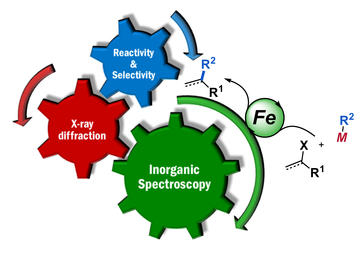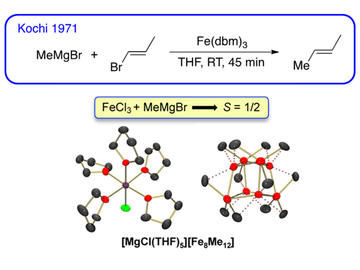

To address these challenges, our group utilizes an innovative experimental approach combining inorganic spectroscopic methods (e.g. Mössbauer, electron paramagnetic resonance (EPR), magnetic circular dichroism (MCD)), density functional theory (DFT), synthetic/catalytic and kinetic studies to define the key parameters required for high catalytic activity. Our prior work with this approach has revolutionized our understanding of iron cross- coupling in areas including elucidation of Kochi’s S = 1/2 species and the role of NMP in cross-coupling with simple ferric salts2 (both decades long mysteries), the importance of iron(II)-ligand species in cross-coupling, and the role of TMEDA and alkoxide additives in catalysis, and three-component radical cross-couplings. These studies have provided the foundation for improvements in catalyst activity by defining the roles of ligands, additives and reaction conditions in generating specific active iron species in situ, as well as enabling hypothesis driven ligand and pre-catalyst development.
Selected Publications
- Neidig, M. L.; Carpenter, S. H.; Curran, D. J.; DeMuth, J. C.; Fleischauer, V. E.; Iannuzzi, T. E.; Neate, P. G. N.; Sears, J. D.; Wolford, N. J. Acc. Chem. Res. 2019, 52, 140-150.
- Liu, L.; Aguilera, M. C.; Lee, W.; Youshaw, C. R.; Neidig, M. L.; Gutierrez, O. Science 2021, 374, 432-439.
- Bakas, N. J.; Sears, J. D.; Brennessel, W. W.; Neidig, M. L. Angew. Chem. Int. Ed. 2022, e202114986.
- Aguilera, M. C.; Gogoi, A. R.; Lee, W.; Liu, L.; Brennessel, W. W.; Gutierrez, O., Neidig, M. L. ACS Catal. 2023, 12, 8987-8996.